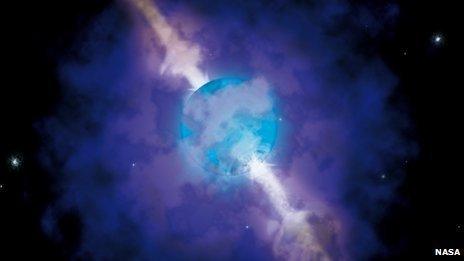NASA's Swift satellite observes massive supernova stars
- Published
- comments

An artist's impression of a blue supergiant star during a gamma-ray burst
The great thing about astronomy is there's so much of it out there and so much we just don't understand. But never underestimate how ingenious science can be in trying to find out what's going on.
NASA's Swift satellite is just one example of this - a small satellite designed to detect and then quickly turn to face gamma-ray bursts as they occur anywhere out there in the universe. Unusually for a space mission, Swift doesn't stand for anything. Instead, the satellite is named for its ability to move so rapidly.
Since its launch in 2004, Swift has detected over 700 gamma-ray bursts. Some bursts are over in a minute, some last a little bit longer but now researchers at the University of Warwick have discovered just three that last for several hours.
Dr Andrew Levan from the University of Warwick says these longer gamma-ray bursts are actually caused by really, really big stars going supernova. That is using up all their fuel and exploding in a brilliant burst of energy.
We call these stars supergiants and they are 20 times more massive than our own sun and so when these stars go supernova they expand to a radius of up to a billion miles, becoming the biggest and brightest star in the universe.
When a supergiant finally goes bang it produces a massive burst of gamma rays and that burst lasts much longer because the supergiant is so big and there's much more fuel to burn through.
The bursts Swift is detecting are a sign of one of the most spectacular explosions in the universe. As Dr Levan explained to me from America, where the results are being revealed for the first time, if we could see gamma rays ourselves these events would outshine everything else in the sky.
To detect and explain this previously unknown type of gamma-ray burst is a real achievement for the University of Warwick. Dr Levan presented his paper, external at the GRB 2013 Symposium in Nashville, Tennessee.